June 9, 2024. Most of the time, Pieter has good success in finding photos of soldiers named on photo wish lists from the three Canadian War Cemeteries in The Netherlands. This past winter, however, he ran into one frustration after another. In most cases, while family of soldiers were found, no one had photos. A few times, family members were found, but did not respond to inquiries.
..…An old TV program inspired one photo search …..
Pieter was getting a bit discouraged. It didn’t help that I was not well for much of the winter and spent most of the time reading and watching comedies on TV. Since we’d been doing research on airmen who had been POWs I began watching Hogan’s Heroes, a comedy about POWs assigned to form a special operations unit in a POW camp run by the Luftwaffe to help prisoners escape and to perform acts of sabotage against the German war effort. A very funny satire and I’m sure that laughing over the antics these men got up to helped me recover more quickly.
So, when Pieter began looking at his photo wish lists again, he asked if I had any thoughts on which soldier to research. I didn’t until I noticed a soldier named Carter, who came from a place named Central Blissville. That’s the guy, I told Pieter. When he asked why, I told him there was a character on the show named Sgt Carter and who could resist a place named Blissville? Pieter shook his head, but went with my suggestion and within a day had a photo!
Before telling the story of the Canadian soldier named Carter, take a look at this excerpt from Hogan’s Heroes, featuring the fictional American soldier named Carter, portrayed by Larry Hovis, impersonating the German commandant of the POW camp…
..…The non-fictional Private Carter enlisted in 1941…..
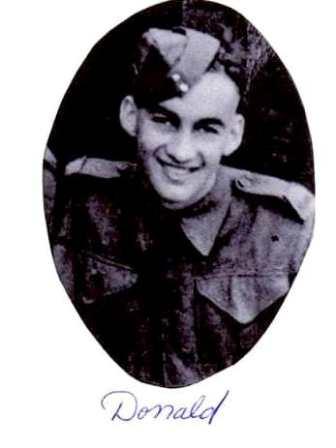
Donald Roy Carter. (Source: Jeremy Carter)
The non-fictional Donald Roy CARTER was born August 4, 1923 in Central Blissville, Sunbury County, New Brunswick, son of Roy William and Josephine ‘Ina’ Helen Carter. However, when he enlisted at the No. 7 District Depot in Fredericton, New Brunswick, on May 3, 1941, he stated that his birthdate was May 27, 1922. Since a soldier in active service needed to be 19 years old, Donald fudged his date of birth.
On May 22, 1941, Donald was sent to No. 70 Canadian Army (Basic) Training Camp (CABTC) in Fredericton, New Brunswick for basic training. After completing his basic training, he was transferred to the A22 Canadian Army Medical Corps Training Centre at Camp Borden in Ontario. Here Donald received advanced training to prepare him as a stretcher bearer, with three key responsibilities when dealing with the wounded in a war zone: stop the bleeding, treat for shock, and evacuate.
….Donald left Canada for overseas service….
On September 6, 1941, Donald was given embarkation leave of just over a week, and then he found himself on his way to the United Kingdom on October 9, 1941. Upon arrival in Greenock, Scotland on October 19, 1941, he was assigned to No. 1 General Holding Unit.
A Holding Unit was a reinforcement pool where soldiers brought over from Canada received additional training.
On December 13, 1941, Donald was transferred to the 11th Field Ambulance, Royal Canadian Army Medical Corps (RCAMC). A field ambulance was a mobile medical unit which was usually found serving with an infantry division during WWII.
….Donald survived Operation Jubilee – the Dieppe Raid….
Allied Forces had plans for an amphibious attack on the German-controlled port of Dieppe in Normandy, France in 1942, in what would become known as Operation Jubilee, also called the Dieppe Raid. (See https://en.wikipedia.org/wiki/Dieppe_Raid)
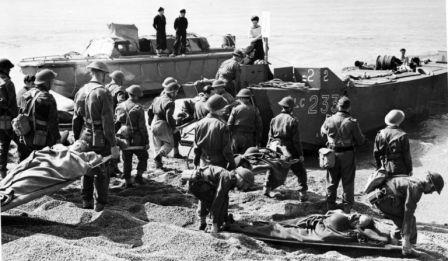
Royal Canadian Army Medical Corps personnel treating casualties during rehearsal in England for raid on Dieppe. (Photo Source: Global News)
As part of the preparations, the 11th Field Ambulance underwent training on the Isle of Wight. An exercise on June 4, 1942 included practice in moving casualties from an assault landing craft to an advanced dressing station. They also practiced opposed and unopposed beach landings. Two final, large, exercises took place along the Dorset Coast on June 11-12, 1942 and June 22-24, 1942.
On August 18, 1942, Donald was among the members of the 11th Field Ambulance that assembled at Newhaven, with one bearer section (1 Medical Officer and 18 other ranks) detached to the Royal Regiment of Canada at Portsmouth. They all sailed toward Dieppe at about 9:30 pm.
Unfortunately, Operation Jubilee was a disaster, particularly for the Canadian soldiers, and the medical unit attached to the Royal Regiment of Canada. 3,623 of the 6,086 Allied forces who landed were killed, wounded, or taken prisoner of war. This included 5,000 Canadians, who suffered a 68 percent casualty rate, with 3,367 killed, wounded, or taken prisoner.
Donald, however, survived and safely returned to the United Kingdom on August 19, 1942, where he remained until shortly after D-Day.
….Donald returned to Normandy in July 1944….
On July 3, 1944, Donald and the 11th Field Ambulance, now part of the 21st Army Group, returned to Normandy, France as the Battle of Normandy continued following the advances made on D-Day on June 6, 1944.
As the 2nd Canadian Corps advanced in July, the 11th Field Ambulance moved along with them, as part of the 2nd Canadian Infantry Division (along with other medical units). 11th Field Ambulance was tasked with providing support to the 4th Canadian Brigade. During battle on July 18-19, 1944 they treated casualties, before making preparations to move forward on July 20, 1944 for Operation Spring at Verrieres Ridge on July 25, 1944.
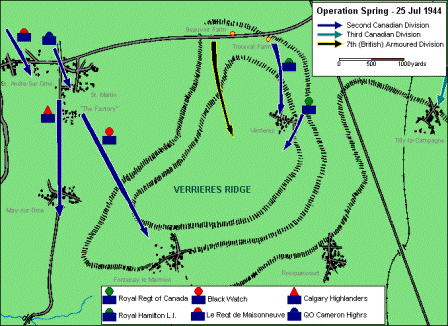
Map shows troop locations for Operation Spring. (Map source: http://www.canadiansoldiers.com)
Donald survived the fight along the Verrieres Ridge, most likely because the 11th Field Ambulance was not at the front, but was held in reserve in Caen for the 2nd Canadian Motor Ambulance Convoy. (See https://www.canadiansoldiers.com/history/battlehonours/northwesteurope/verrieresridge.htm)
Then, during Operation Totalize on August 7-11, 1944, an offensive designed to break through the German defences south of Caen and toward Falaise, the 11th Field Ambulance was under command of the 2nd Canadian Armoured Brigade. (See https://en.wikipedia.org/wiki/Operation_Totalize)
….Donald had limited participation in the Battle of the Scheldt….
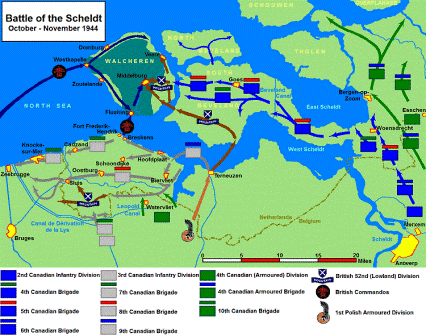
Map shows location of South Beveland, The Netherlands. (Map source: http://www.canadiansoldiers.com)
As the Allied forces moved from Normandy into Belgium, and then into The Netherlands for the Battle of the Scheldt, three Field Ambulances of the 2nd Canadian Division were used in Operation Vitality, the battles for South Beveland for a month from October 2, 1944.
Each Field Ambulance unit operated an advanced dressing station and a casualty collection post. 11th Field Ambulance evacuated casualties directly to No. 6 Canadian General Hospital in Antwerp, Belgium. (See https://en.wikipedia.org/wiki/Battle_of_the_Scheldt and https://www.oorlogzeeland.nl/index.php/slag-om-de-schelde/scheldeslag-information-in-english)
However, Donald missed much of the action as he was not on active service between October 16 and November 12, 1944. This effectively ended his time with the 11th Field Ambulance.
….Donald was transferred into the Infantry….
On November 24, 1944 Donald was transferred to the Canadian Infantry Corps, as part of the X4 Reinforcement for the 13th Battalion. Then, on December 4, 1944 he was assigned to the Essex Scottish Regiment, joining them in Mook, The Netherlands.
On February 16, 1945, the Essex Scottish Regiment left The Netherlands and crossed the border into Germany, at Kleve. The following day, the war diary reported that the battalion “…moved off to an assembly area between Kleve and Calcar….” in preparation for an attack on the Goch-Calcar Road, which was subsequently delayed until February 19, 1945.
….Heavy fighting along the Goch-Calcar Road proved deadly….
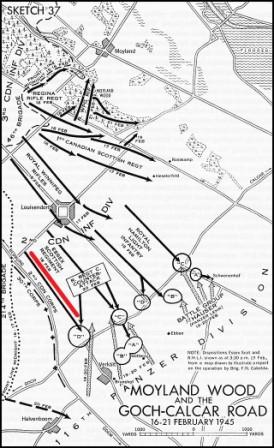
Moyland Wood and the Goch-Calcar Road, 16-21 February 1945 (Map source: HyperWar: The Victory Campaign [Chapter 18] ibiblio.org)
The war diary for February 19, 1945 noted that the attack on the Goch-Calcar Road resulted in the Regiment fighting “….under a heavy hail of shrapnel and small arms fire. Casualties were fairly heavy….Communications were difficult. Vehicles became bogged in the soft mud, casualties were difficult to evacuate, and guns and ammunition could not get up where they were required….”
The battle raged on into the night and then after midnight communications were lost. The war diary entry for February 20, 1945 continued with an account of the battle. “… The early hours of the morning were grim ones. Isolated company groups fought on, short of ammunition, burdened with casualties which could not be easily evacuated, and lacking the support of the anti-tank weapons with which to deal with the Mark IV tanks the enemy had marshalled for his counter-attack….”
The casualties for the battle numbered “…13 officers and 235 other ranks…” of which about 50 were fatalities. Among those killed on February 20, 1945 was Private Donald Roy Carter, who lost his life at the age of 21.
..…Donald is buried in Groesbeek …..
Donald was temporarily buried near Calcar, Germany, before being reburied the following year in the Canadian War Cemetery in Groesbeek, The Netherlands.
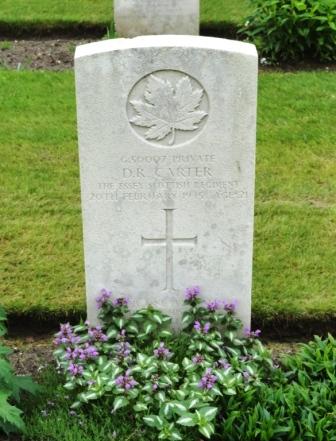
Grave of Donald Roy Carter in the Canadian War Cemetery in Groesbeek, The Netherlands. (Photo source: http://www.findagrave.com)
Do you have photos or information to share? Email Pieter at memorialtrail@gmail.com, comment on the blog, or tweet to @researchmemori1.
© Daria Valkenburg
….Want to follow our research?….
If you are reading this posting, but aren’t following our research, you are welcome to do so. Our blog address: https://onthewarmemorialtrail.com/
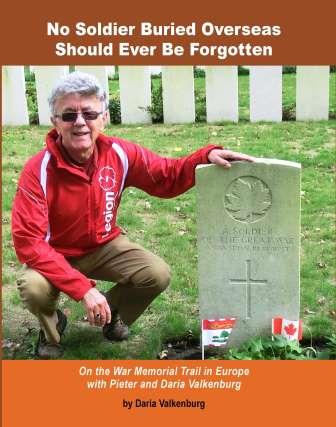 4 countries, 6 weeks, 7,000 km – an unforgettable war memorial journey in Europe…. Daria’s book ‘No Soldier Buried Overseas Should Ever Be Forgotten‘ is available in print and e-book formats. Net proceeds of book sales help support research costs and the cost of maintaining this blog. For more information see https://nosoldierforgotten.com/
4 countries, 6 weeks, 7,000 km – an unforgettable war memorial journey in Europe…. Daria’s book ‘No Soldier Buried Overseas Should Ever Be Forgotten‘ is available in print and e-book formats. Net proceeds of book sales help support research costs and the cost of maintaining this blog. For more information see https://nosoldierforgotten.com/
You are also invited to subscribe to our YouTube Channel: On The War Memorial Trail With Pieter Valkenburg: https://www.youtube.com/channel/UCJ591TyjSheOR-Cb_Gs_5Kw.
Never miss a posting! Subscribe below to have each new story from the war memorial trail delivered to your inbox.
Loved the Hogan’s Heroes story!
LikeLike
Thank you Mary Ann! It’s amazing how often a reference pops up that leads to success in finding a photo or a soldier’s family……Daria and Pieter
LikeLike
Hi Daria,
I thought that the Canadians had about 907 fallen soldiers and see the Wikipedia page of all the fallen numbers to the right below under casualties and losses. See https://en.wikipedia.org/wiki/Dieppe_Raid
Regards
Edwin van der Wolf
LikeLike
Hi Edwin, The final tally for the Dieppe Raid was estimated at 907 Canadians killed, 2,460 Canadians wounded, and 1,946 taken as POWs. The Canadians had the highest number of casualties of all who were involved in the Dieppe Raid. Daria and Pieter
LikeLike
Thank you for your very quick reply
Edwin
LikeLike